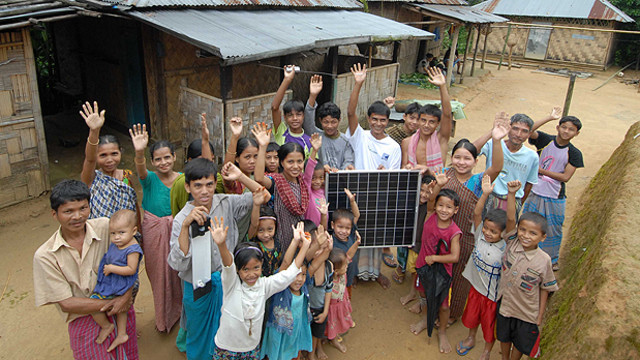Q&A: Linking low-carbon pathways with the SDGs
Youba Sokona discusses the challenges and opportunities around low-carbon development in the context of the Sustainable Development Goals.

The Addis Ababa light rail system opened in 2015, the first to be built in Sub-Saharan Africa. The two railway lines, which have their own dedicated power grid, demonstrate how Ethiopia is seeking low-carbon energy initiatives (Photo: Wikipedia, via Google licence)
The Least Developed Countries (LDC) Independent Expert Group (IEG), IIED and the ESRC's STEPS Centre will host a dialogue on Monday, 13 June on 'Reimagining development in the LDCs: what role for the SDGs?'.
Ahead of the event, IEG member Youba Sokona discusses challenges and opportunities around low-carbon development in the context of the SDGs.
How can the SDGs help drive low-carbon development in LDCs?
YS: Addressing this question would imply LDCs are actively aligning low-carbon initiatives with national sustainable development plans and strategies. But it's my strong sense this is not yet the case.
There seems to be very little dialogue, if at all, on how the SDGs can promote low-carbon opportunities for LDCs. In fact, there seems to be little broader discussion of how the SDGs can support country-driven development strategies within the LDCs.
This became particularly clear to me during visits to a number of African countries as part of the IPCC Fifth Assessment Report outreach activities and the roll-out of the Africa Renewable Energy Initiative (AREI), an ambitious programme set to fill Africa's energy generation gap by 2030.
Launched at the 21st Conference of the Parties (COP21) climate talks in Paris, this initiative will significantly increase supplies of clean energy across Africa, cutting dependence on fossil fuels and avoiding carbon emissions.
But this is about more than tackling climate change. The provision of reliable, affordable, renewable energy can lift people out of poverty, it can enhance wellbeing, generate sustainable jobs, and safeguard natural resources. In fact, one could argue that such an initiative speaks to all of the SDGs.
AREI is an ambitious programme and a major contributor to the continent achieving its sustainable development aspirations.
However, based on conversations with different government ministries, LDCs do not seem to be making the connection of how low-carbon initiatives fit into the broader sustainable development agenda.
Achieving the goals will require cross-sector collaboration where ministries of environment, health, transport, agriculture all work together to drive implementation.
How can this be addressed?
YS: SDGs have been agreed at the global level but each country needs a clear strategy and clear plans to implement the goals in the national and local context. This will require inclusive, transparent and action-focused discussion.
And these dialogues need to be ongoing. To achieve the SDGs, we can use the metaphor of a headache and high blood pressure. If you have a headache, you can take a pill and your headache's gone. Sustainable development is like high blood pressure – you need to take medication on a continuous basis to manage your condition while taking steps so it doesn't worsen.
If countries are to succeed in achieving the SDGs there must be ongoing engagement with all stakeholders, iterative planning at national level and careful monitoring.
I think we can revisit Article 6 of the UN Framework Convention on Climate Change (UNFCCC) where information sharing, education and awareness raising on a continuous basis is needed to achieve lasting solutions to climate change.
So too with the SDGs – we need to understand the risks and opportunities, be ready to share knowledge and to learn from each other, to change our behaviours, if we are to achieve these goals.
What are the opportunities for LDCs in pursuing low-carbon initiatives?
YS: The energy systems in many LDCs are not yet in place. While other parts of the world attempt to decarbonise, these countries have a big opportunity to leapfrog to low-carbon technologies.
In bypassing the dirty development of heavily industrialised countries, LDCs have a real head start in the shift towards sustainable development.
And the challenges?
YS: Many low-carbon activities and initiatives already exist at national, regional and continental level. It's vital to assess what's already in place to avoid duplication and ensure a coordinated approach.
National plans for renewable energy deployment may indicate a certain level of progress but the reality on the ground may be completely different. Thorough mapping of what's really happening in LDCs avoids any preconceived ideas of how advanced countries are in their low-carbon development.
Helping countries to conceive and develop sound policies with clear objectives is crucial.
What about the financing gap?
YS: At international level, many think financing low-carbon pathways is the main problem. Finance is crucial but strong policy is a prerequisite.
Ultimately, it is clear policies and transparent regulatory frameworks that will stimulate investment. If these are in place, the finance will follow.
And what about access to low-carbon innovations – is it the private sector that will drive this?
YS: The private sector has an important role to play, but let us remind ourselves: across Europe, the US and all over the developed world, the private sector has done very little to increase clean energy access for the poor.
In my view, low-carbon innovations will come from the public sector. We have to debunk this myth that in pursuing low-carbon pathways, finance is the only problem and the private sector is the only solution.



